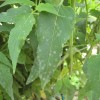Pentland Brig Kale
Details Open-Pollinated Type: curled edged leaves Shape: ? Color: ? Maturity: 8-9 weeks (50-60 days) Size: 2′ plants Yield: 76-153 lbs per 100 sq ft Taste: “delicate, sweeter and more succulent” “tender and succulent leaves” Disease Resistance or Environmental Tolerance: very winter hardy tolerates hot weather more than most kale Notes: produces excellent kale raab […]

